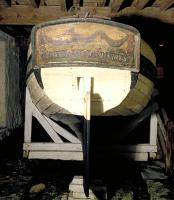
Peggy of Castletown
Peggy, the oldest yacht in the UK and the oldest schooner in the world, is being restored. Sometime between 1786 and 1791, George Quayle of Castletown, on the Isle of Man, had a shallop built, which he named Peggy. A shallop is a light sailboat built for coastal fishing, as a tender, or in the case of Peggy, as a pleasure craft. According to National Historic Ships UK, she may have worked as as a cargo vessel in the Irish Sea and around Liverpool sometime between 1791-1835. There is also evidence that she may have been armed with six cannon and two stern chasers. The shallop was also fitted with sliding keels.
Following George’s Quayle death in 1835, Peggy was put in storage in a subterranean boat shed and was largely forgotten about. One hundred years later, Emily Quayle bequeathed Peggy and the boat shed to the Isle of Man.
Now after several surveys and modest preservation work, the 26′ long clinker built open boat will be moved to a climate-controlled conservation facility in Douglas recently purchased by the Manx Museum and National Trust, to be stabilized, examined and conserved.
Christopher Weeks, Objects Conservator at Manx National Heritage said the Peggy needed “urgent conservation work”.
“The humidity of the new surroundings has to be lowered carefully in order to retard the corrosion of her iron fittings without damaging her timbers,” he explained. “At the same time preservation work on her painted surfaces will also commence. However, this complex conservation project is in its earliest stages. We can’t be specific about exactly what we need to do, or a timescale, until we can properly assess the boat’s condition in a secure environment. The ‘Peggy’ is one of the most important historic artefacts in the British Isles and we are looking to conserve her, create a suitable environment in which to house her and to tell her story for future generations.”
John Leather, in his book The Gaff Rig Handbook: History, Design, Techniques, Developments, describes the Peggy:
The world’s oldest schooner is preserved at Castletown, Isle of Man, England; a 26-footer clearly linking the rig with the two-masted shallop. The Peggy was built in 1791 as a general service boat for the Quayle family who were Island bankers and businessmen, owning several small craft for pleasure sailing and trips to the mainland. She is an open boar 26ft 5in overall, 24ft 5in waterline x 7ft 8in beam. Her hull form is typical of contemporary small craft, with steep rise of floor, slightly flared sides and a lute stem. She has a full forward deckline but a fine entry and run. The clench planking is stiffened by sawn frames notched over the lands. The foremast is stepped in the extreme bow, shallop fashion, and is clasped to a thwart. The mainmast is just aft of amidships and both are stayed with two shrouds each side. The foresail is boomless and the main boom overhangs the stern considerably. A long bowsprit spreads a large staysail which turns her from a two-masted shallop to a small schooner.
In 1796 Peggy sailed to the mainland and was trailed behind horses to Lake Windermere where she raced against local craft before being brought back. Before Peggy was launched, George Quayle, elder son of the family, appropriated her and, despite her good sailing form, had three experimental daggerboards fitted; a device then under experiment in the warship Trail and much discussed in maritime circles since the British Naval officer Captain Shank had first tried a ‘sliding keel’ at Boston, in 1774.
For well over a century Peggy has lain preserved in a Castletown boathouse which has become a museum. She has marked similarity with the form and rig of contemporary Chebacco boats built in New England for fishing.
Thanks to Frank Hanavan for passing the news along.

Pingback: Scheepvaartnieuws | Bootjesgek.nl
I think “Conserved” would be the better word.
Always enjoy the blog 🙂
Reading further into the extent of the work required, I think “restored” is appropriate, though it could be a close call.
Glad that you enjoy the blog.